You’re staring at a business process that’s slow, expensive, and prone to human error. You know the answer is automation. But as you explore the options, you’re hit with a dizzying array of terms: Robotic Process Automation (RPA), AI, cognitive automation, intelligent agents. It feels like a minefield. If you choose the wrong path, you risk investing in a brittle, high-maintenance system that breaks with the slightest change. If you choose the right one, you unlock a new level of strategic advantage.
So, what is the real, fundamental difference in the intelligent agent vs automation debate?
Table of Contents
The real difference is that basic automation is a tool that mimics human clicks, while an intelligent agent is a system that mimics human judgment.
Basic automation, in the form of Robotic Process Automation (RPA), is fundamentally “rule-based.” It’s a digital assembly line worker, programmed to follow a rigid, explicit script: IF you see this exact thing in this exact spot, THEN perform this exact action. It has no understanding of the why behind its tasks.

In stark contrast, an intelligent agent is “goal-oriented.” It operates like a seasoned project manager. You don’t give it a script; you give it an objective. Using a powerful combination of Artificial Intelligence, it reasons, plans, and navigates unforeseen obstacles to achieve its goal. It understands context.
Think of it this way: basic automation is a train on a fixed track. It’s incredibly fast and efficient as long as the track is perfect and unchanging. An intelligent agent is an all-terrain, self-driving vehicle. You give it a destination (a goal), and it uses its sensors and intelligence to navigate a dynamic, unpredictable world—handling traffic, detours, and roadblocks to find the most effective path.

This guide will move beyond the buzzwords to provide a deep, strategic analysis of these two technologies. We will dissect their underlying mechanics, explore data-backed real-world scenarios, and provide a clear framework for deciding which approach will drive true transformation for your business.
The Digital Assembly Line: A Deep Dive into Basic Automation (RPA)
Before we can appreciate the leap to intelligent agents, we must understand the power and the pitfalls of their predecessor. Basic automation’s most common form is Robotic Process Automation (RPA), a technology that has delivered immense value by tackling the low-hanging fruit of digital work.
What is “Rule-Based Automation” at its Core?
At its heart, rule based automation is the science of digital mimicry. An RPA “bot” is a software script designed to interact with a computer’s user interface (UI) in the same way a human does. It’s programmed to perform a sequence of actions:
- Log into an application.
- Open an email and its attachment.
- Copy data from a specific cell in a spreadsheet.
- Paste that data into a specific field in a CRM.
- Log out.
The logic is always a rigid, unchanging “if-this-then-that” command structure. The bot doesn’t understand what an “invoice” is; it only knows that it needs to copy the text from a specific coordinate on the screen.

The Strengths and Limitations of RPA: The “Brittle” Powerhouse
Understanding the rpa benefits and limitations is crucial for any leader.
Strengths:
- Tactical Speed & Efficiency: RPA bots are incredibly fast, capable of performing repetitive tasks 24/7 without error, often reducing processing times for specific tasks by up to 70%.
- Non-Invasive Implementation: Because they interact with the UI, RPA bots can be deployed without complex and costly API integrations, making them a quick solution for legacy systems.
- Fast ROI for Stable Processes: For high-volume, completely stable, and predictable tasks, the return on investment can be rapid, often seen within 6 to 9 months.
Limitations:
- The Brittleness Problem: This is RPA’s Achilles’ heel. If a website changes a button’s color, a form field is moved, or a software application is updated, the bot’s script breaks. It can’t adapt because it has no underlying understanding. This leads to high maintenance and a high Total Cost of Ownership (TCO).
- Dependency on Structured Data: RPA requires perfectly structured, predictable data. It cannot handle variations. The difference between structured vs unstructured data is the wall that basic automation cannot climb.
- Inability to Handle Exceptions: Any scenario not explicitly programmed into its script is a complete roadblock. It cannot problem-solve; it can only stop and report an error.
Basic automation is a phenomenal tool for automating simple, high-volume tasks. But it automates the hands, not the brain. To do that, we need a different class of technology.
The Autonomous Problem-Solver: Anatomy of an Intelligent Agent
This is where the conversation shifts from tactical efficiency to strategic transformation. An intelligent agent is not just a faster pair of digital hands; it’s an emerging digital brain.
What is an Intelligent Agent?
An intelligent agent is an AI-powered system that can perceive its environment, make autonomous decisions based on reasoning and learning, and execute multi-step actions to achieve a specific, high-level goal.
It moves beyond the “how” to the “why.” You don’t tell it how to do something; you tell it what you want to accomplish. This is the most critical distinction in the intelligent agent vs automation debate.
The Technology Stack: The “Intelligence” Inside the Agent
The “intelligence” is not a single thing but a layered stack of sophisticated technologies. The difference between robotic process automation vs artificial intelligence lies in the power of this stack.
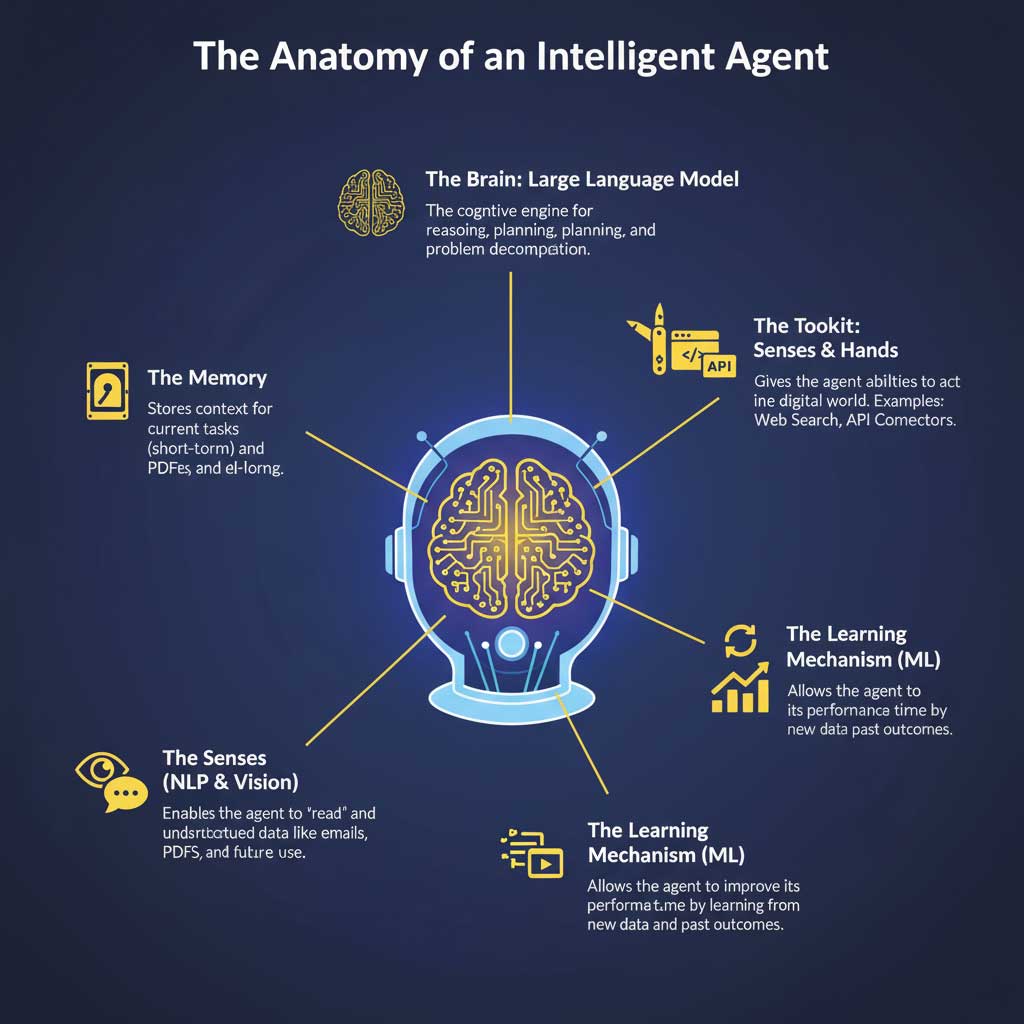
- Artificial Intelligence (AI): The foundational field of creating systems that can perform tasks requiring human intelligence.
- Machine Learning (ML): This is the agent’s ability to learn. By analyzing vast amounts of data, it can identify patterns, make predictions, and improve its performance over time without being manually reprogrammed. This is how an agent gets smarter.
- Natural Language Processing (NLP): This allows the agent to comprehend, interpret, and generate human language. It’s what lets an agent read an email, understand a customer’s complaint, or extract key information from a dense legal contract.
- Computer Vision: The ability to “see” and interpret information from images and videos, crucial for processing scanned documents or understanding on-screen elements contextually.
- Large Language Models (LLMs): Acting as the agent’s central “brain” or reasoning engine, models like GPT-4o provide the ability to understand complex prompts, decompose them into logical plans, and orchestrate the use of other tools to execute those plans.
The Head-to-Head Showdown: Intelligent Automation vs RPA
To make a truly informed strategic decision, a direct comparison is essential. This table breaks down the critical differences, moving beyond technical features to business implications.
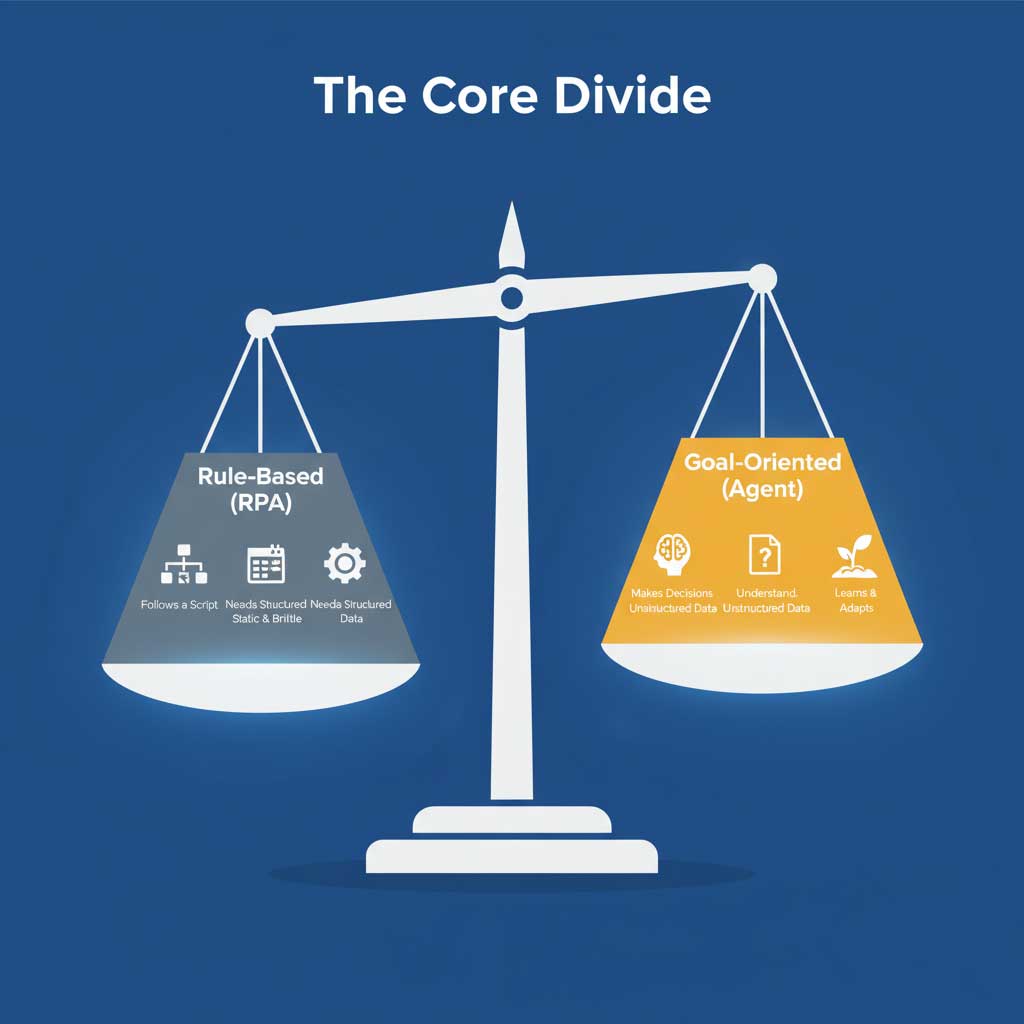
| Feature | Basic Automation (RPA) | Intelligent Agent (AI-Powered) |
| Core Logic | Rule-Based: Follows a pre-programmed script. “IF this, THEN that.” | Goal-Oriented: Uses AI to determine the best path to an outcome. |
| Decision-Making | Static & Pre-defined. Cannot handle new scenarios. | Dynamic & Adaptive. Makes real-time judgments based on data and context. |
| Data Handling | Structured Data Only: Requires predictable formats (spreadsheets, specific form fields). | Structured & Unstructured Data: Can read and interpret emails, PDFs, images, and natural language. |
| Adaptability | Brittle: Breaks when applications or UIs change. Requires manual reprogramming. | Resilient: Can adapt to changes in interfaces and processes. Learns from experience. |
| Error Handling | Stops or follows a simple, pre-defined exception path. | Can problem-solve autonomously (e.g., retry a task, find an alternative data source). |
| Implementation Mindset | Task Automation: Focuses on automating a single, discrete task within a larger process. | Process Orchestration: Focuses on automating and optimizing an entire end-to-end business workflow. |
| Primary Business Goal | Tactical Efficiency: Reduce cost and time for a specific, high-volume task. | Strategic Transformation: Automate complex, end-to-end business workflows and enable new capabilities. |
Real-World Scenarios: A Tale of Two Automations
Let’s ground this in reality. Here are four common business scenarios that perfectly illustrate the profound difference in capability.
Scenario 1: Invoice Processing
The Basic RPA Approach
An accounts payable clerk uses an RPA bot to process invoices. The bot is programmed to open PDFs from an email inbox, extract the “Total Amount” from a specific coordinate on the page (e.g., 2 inches from the top, 5 inches from the left), and enter it into the accounting software. This works flawlessly for the 80% of invoices that use the standard template. For the other 20%—new vendors, special formats, credit memos—the bot fails, creating a manual, time-consuming exception queue.
The Intelligent Agent Approach
This is the domain of Intelligent Document Processing (IDP). An intelligent agent doesn’t care about coordinates. It uses computer vision and NLP to read the invoice like a human. It identifies the text “Total Due” or “Amount Payable” and understands the number next to it is the correct figure, regardless of where it appears. It can process thousands of different invoice formats from a single model and can even be trained to cross-reference purchase orders and flag discrepancies, reducing manual data entry errors by over 95%.
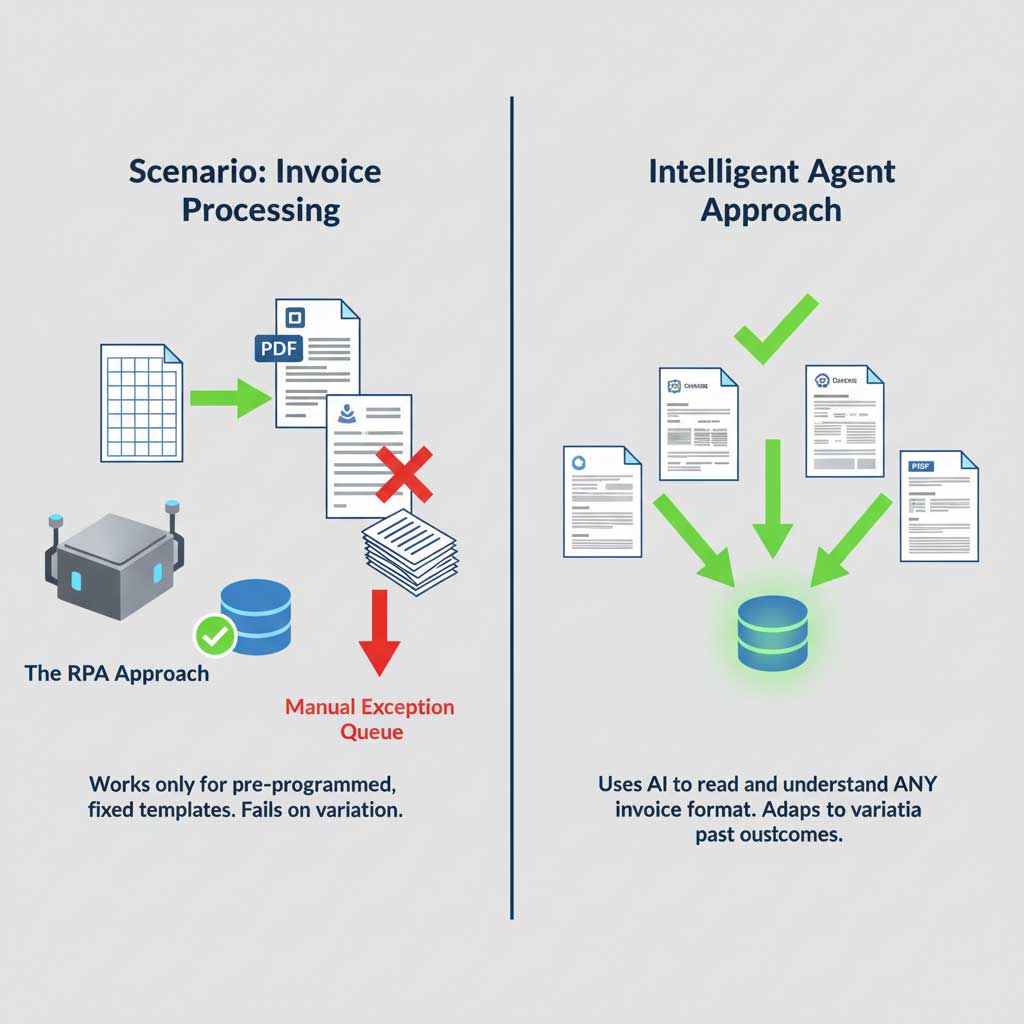
Scenario 2: Customer Support Ticket Routing
The Basic Automation Approach
A simple automation rule scans incoming support emails for keywords. If it finds “refund,” it routes the ticket to the Billing queue. If it finds “broken,” it routes to Technical Support. But what about an email that says, “I’m incredibly frustrated, my new device isn’t working as advertised and I’m considering returning it”? The keyword system gets confused and likely misroutes the ticket, leading to a poor customer experience.
The Intelligent Agent Approach
An agent with NLP capabilities reads the entire email and understands its intent and sentiment. It recognizes the customer’s frustration, identifies the technical nature of the complaint (“isn’t working”), and notes the churn risk (“considering returning it”). It routes the ticket with over 98% accuracy to a senior technical support specialist, marks it as high-priority, and attaches a summary of the customer’s recent purchase history from the CRM. This is the essence of cognitive automation.
Scenario 3: Sales Lead Nurturing
The Basic Automation Approach
A lead downloads a whitepaper and is immediately put into a rigid, 5-email drip campaign. They receive the same generic emails as everyone else, regardless of their company, role, or interests. The campaign is a monologue, not a conversation.
The Intelligent Agent Approach
This is a powerful ai agent use case. The agent monitors the lead’s engagement. When the lead clicks a link to a specific product, the agent dynamically adjusts the nurturing sequence to provide more relevant case studies. It can use a tool to research the lead’s company on LinkedIn, find a recent company announcement, and personalize the next email by referencing it. Based on the lead’s “digital body language,” it can even identify the perfect moment to schedule a meeting with a sales rep, acting as a tireless, intelligent Sales Development Rep.
The Strategic Decision Framework: When to Use RPA vs AI
So, how do you choose? This isn’t just a technical decision; it’s a strategic one. Use this framework to guide your thinking.
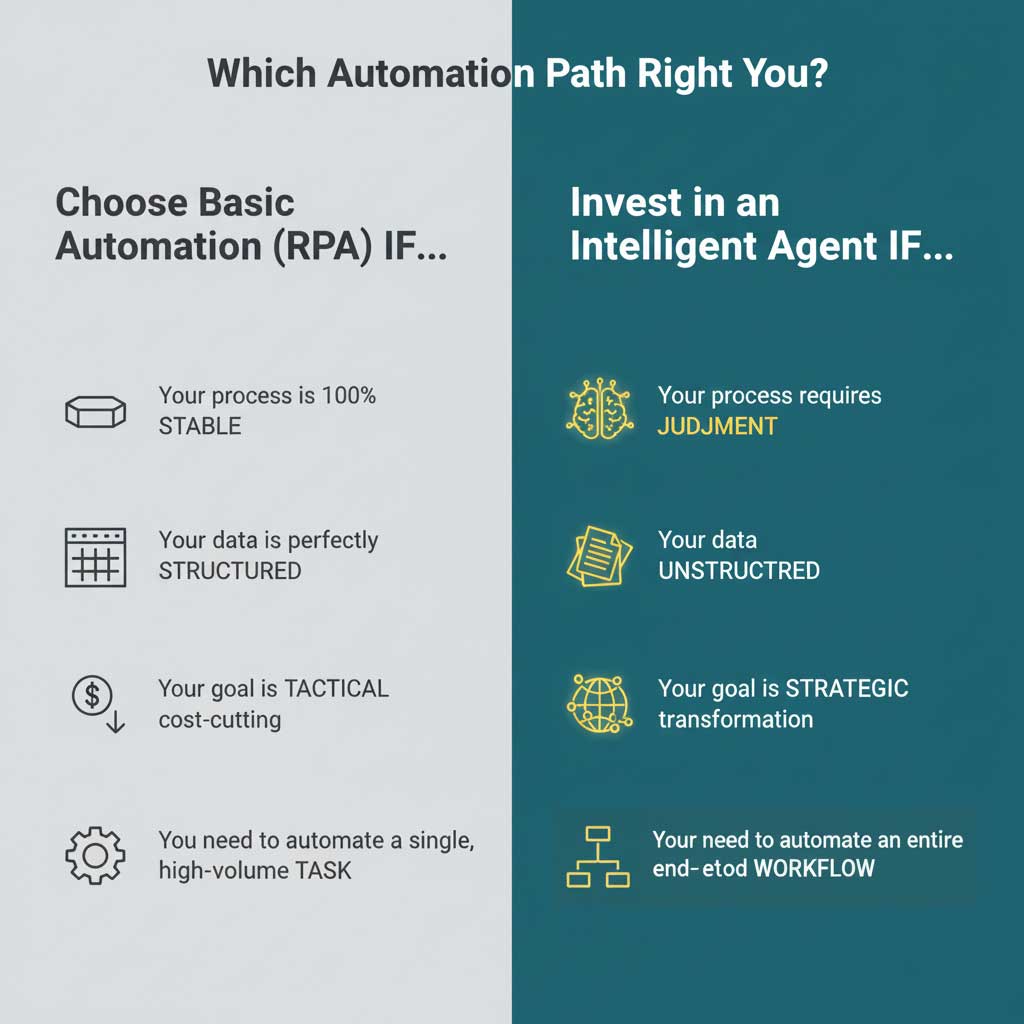
When to Choose Basic Automation (RPA)
A basic, rule-based approach is your best bet when:
- ✅ The Process is Static: The workflow and the user interfaces of the applications involved are extremely stable and rarely change.
- ✅ The Data is Purely Structured: You are dealing exclusively with clean, predictable data in spreadsheets, databases, or fixed forms.
- ✅ The Goal is Tactical Efficiency: Your primary objective is to reduce the cost and time spent on a single, high-volume, repetitive task.
- ✅ Your Tolerance for Upfront Investment is Low: You need a quick win on a simple process and can handle the potential for future maintenance costs.
When to Invest in an Intelligent Agent
An intelligent, goal-oriented approach is necessary when:
- ✅ The Process Requires Judgment: A human currently has to make decisions, interpret information, or handle exceptions.
- ✅ The Data is Unstructured or Variable: You need to process information from emails, PDFs, customer chats, legal documents, or images.
- ✅ The Process is Dynamic: Your business rules, applications, or external websites are constantly evolving. You need a system that can adapt.
- ✅ The Goal is Strategic Transformation: You aim to automate an entire end-to-end workflow, improve decision quality, and build a lasting competitive advantage.
The Financial Story: ROI vs. Total Cost of Ownership (TCO)
- RPA often presents a seductive initial ROI of intelligent automation projects because its upfront implementation cost for a simple task is lower. However, the hidden costs lie in its Total Cost of Ownership (TCO). According to an estimate by Forrester, maintenance can account for up to 30% of the annual cost of an RPA program due to the constant need to fix bots that break.
- Intelligent Agents require a more significant initial investment in data, AI expertise, and development. However, their ROI is often exponential, not linear. Because they can handle a wider range of tasks and adapt to change, they scale more effectively and deliver far greater long-term value. Their resilience leads to a much lower TCO over time.
The Future is Converging: The Rise of Cognitive Automation
The stark lines of the intelligent automation vs rpa debate are blurring. The industry is not moving towards a future where one replaces the other, but where the two converge.
The Blurring Lines: RPA Platforms are Getting Smarter
Major RPA vendors like UiPath and Automation Anywhere are no longer just selling basic bots. They have heavily invested in acquiring and building AI capabilities, transforming their platforms into “intelligent automation” suites. They now offer IDP, NLP, and machine learning tools, allowing businesses to start with simple RPA and strategically infuse AI into their workflows where needed.
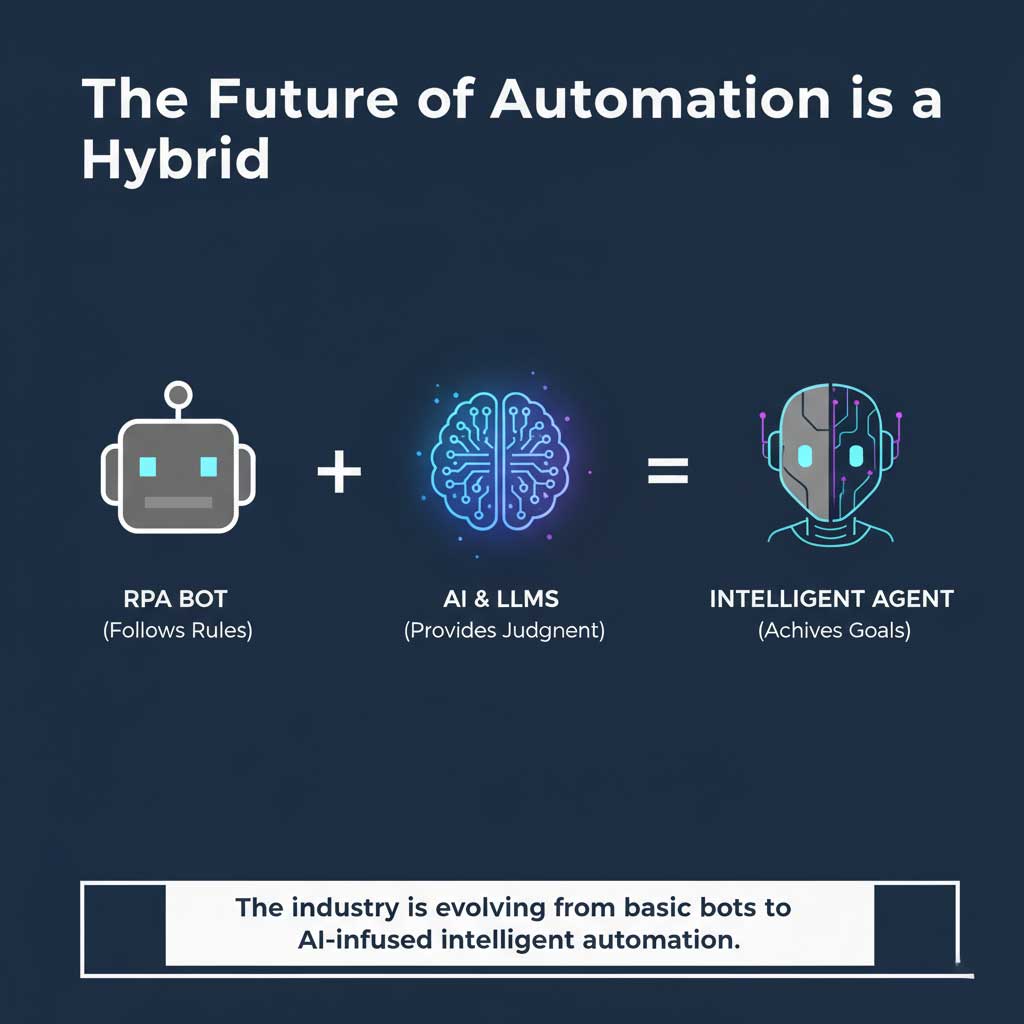
The Role of Generative AI as the “Brain”
The recent explosion in Generative AI and powerful LLMs is the primary catalyst accelerating this convergence. These models serve as an accessible “brain” that can be integrated with RPA “hands and feet.” This allows a traditional bot to understand a user’s intent from a natural language prompt, create its own plan of action, and execute it, effectively turning a rule-based tool into a goal-oriented agent.
How to Prepare for the “Agentic” Future
To stay ahead, businesses must evolve their automation strategy. Stop looking just for repetitive clicks to automate. Start identifying the processes that are currently bottlenecked by human judgment, unstructured data, and complex decision-making. These are the fertile grounds where intelligent agents will deliver transformative growth.
Conclusion: The Right Tool for the Right Job
Ultimately, the choice in the intelligent agent vs automation discussion is not about finding the “best” technology, but about wielding the right tool for the right job.
Basic automation, or RPA, is a tactical hammer. It is an invaluable tool for a specific, well-defined nail: stable, high-volume, rule-based tasks. It delivers immediate efficiency and reduces costs.
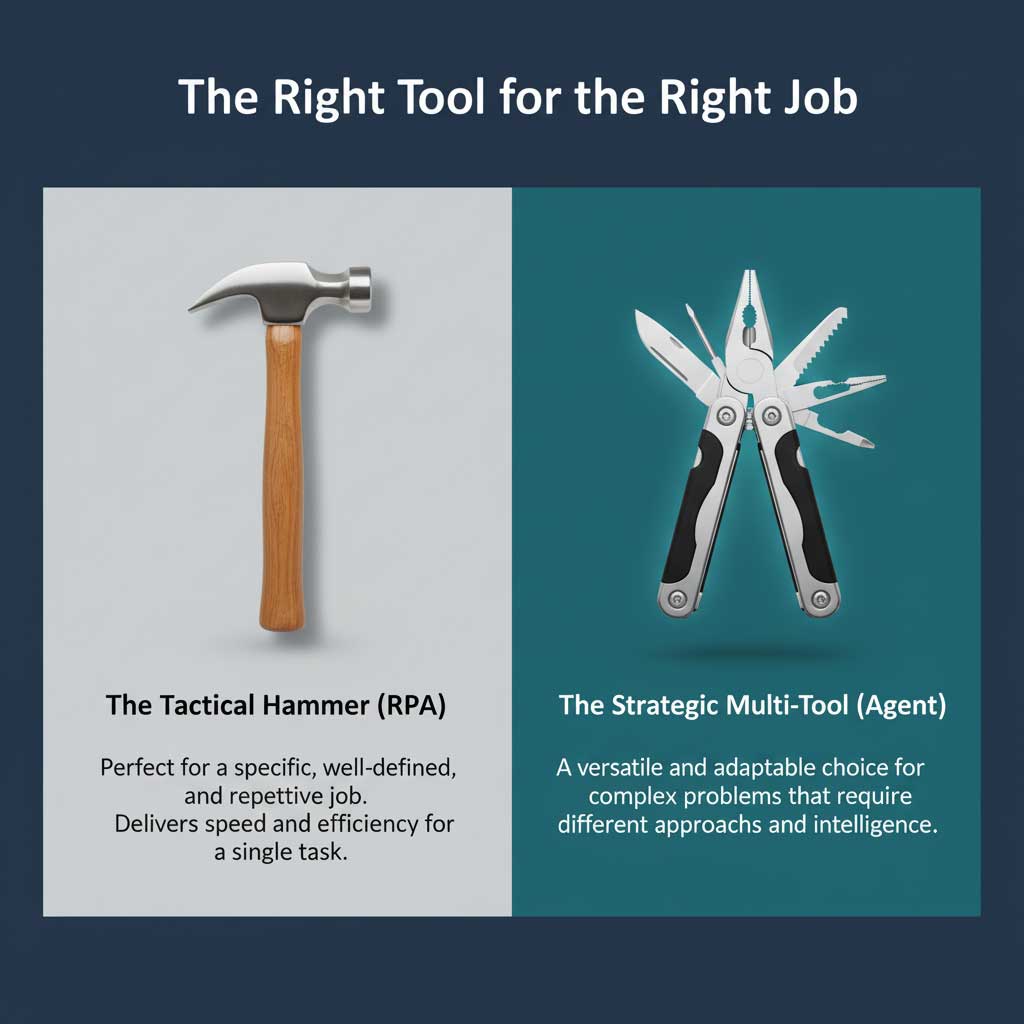
An intelligent agent is a strategic, AI-powered multi-tool. It’s the artisan’s choice for complex, dynamic problems that require judgment, adaptation, and intelligence. It delivers transformation, scalability, and a lasting competitive advantage.
Understanding this fundamental difference is no longer just an IT concern; it’s a critical business strategy. The leaders who master the art of applying the right level of automation to the right problem will be the ones who build the truly efficient, resilient, and intelligent enterprises of the future.
Frequently Asked Questions (FAQ)
1. Can an intelligent agent perform RPA tasks?
Yes, absolutely. An intelligent agent can easily perform simple, rule-based tasks. However, using a sophisticated intelligent agent for a task that a simple RPA bot could handle is often not cost-effective. It’s like using a supercomputer to do basic arithmetic.
2. What’s the difference between cognitive automation and intelligent automation?
The terms are often used interchangeably. Both refer to the use of AI technologies like ML and NLP to automate processes that require human-like judgment and the ability to handle unstructured data. “Intelligent automation” is currently the more common industry term.
3. Is an AI chatbot an example of an intelligent agent?
A basic, rule-based chatbot is not an intelligent agent. However, an advanced conversational AI chatbot that can understand complex user intent, access knowledge bases, and perform actions on the user’s behalf is a type of specialized intelligent agent.
4. How much does it cost to implement an intelligent agent vs. an RPA bot?
An RPA bot for a simple task can be relatively inexpensive to develop or license. An intelligent agent, which requires AI expertise, data, and more complex development, has a significantly higher initial cost. However, its long-term value and scalability are also much higher.
5. What skills does my team need to manage intelligent agents?
You will need a mix of skills, including business analysts who can identify and design workflows, data scientists or AI specialists who can train and fine-tune the models, and IT professionals who can manage the integrations and security.
6. Is RPA technology becoming obsolete?
No, but it is evolving. Standalone, “dumb” RPA is becoming less common. The future of RPA is AI-infused, where bots are augmented with intelligent capabilities, effectively blurring the line between basic automation and intelligent agents.
7. What is Intelligent Document Processing (IDP)?
IDP is a prime example of intelligent automation. It’s an AI-powered technology that uses NLP and computer vision to “read” and understand unstructured and semi-structured documents like invoices, purchase orders, and contracts, extracting relevant data regardless of the layout.
8. How do I calculate the ROI of an intelligent automation project?
The ROI calculation should include not only direct cost savings (like reduced labor hours) but also the value of increased accuracy (fewer errors), improved compliance, faster process cycle times, and enhanced customer and employee satisfaction.
9. What are the biggest security risks with intelligent agents?
Because intelligent agents can access multiple systems and handle sensitive data, security is paramount. Risks include unauthorized access if the agent is compromised, data privacy breaches, and the potential for the agent to make incorrect, high-impact decisions if not properly trained and monitored.
10. What’s the first step my business should take to explore intelligent automation?
Start by identifying a single, high-value business process that is currently bottlenecked by manual decision-making and unstructured data. This could be in customer service, finance, or HR. Run a small pilot project to prove the concept and demonstrate the value before scaling.









